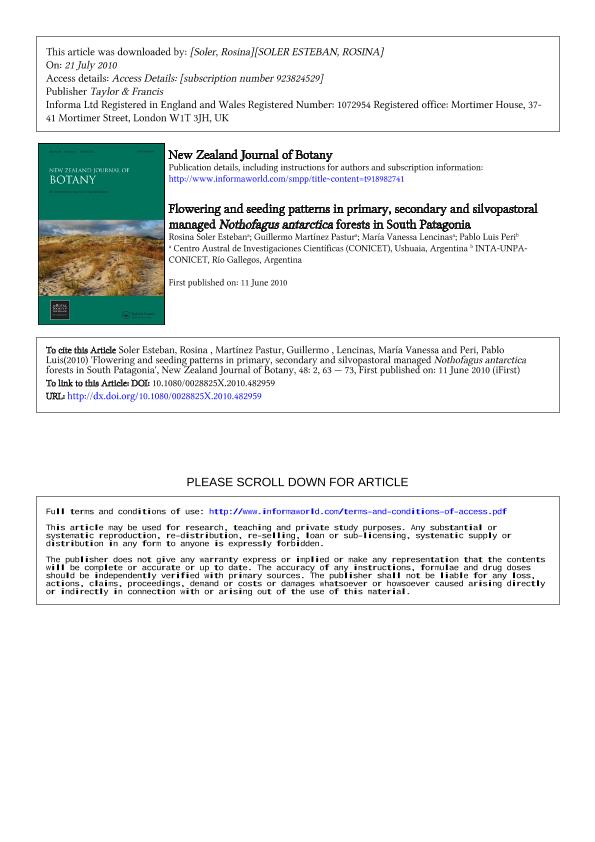Mostrar el registro sencillo del ítem
dc.contributor.author
Soler Esteban, Rosina Matilde

dc.contributor.author
Martínez Pastur, Guillermo José

dc.contributor.author
Lencinas, María Vanessa

dc.contributor.author
Peri, Pablo Luis

dc.date.available
2017-02-09T18:29:27Z
dc.date.issued
2010-04
dc.identifier.citation
Soler Esteban, Rosina Matilde; Martínez Pastur, Guillermo José; Lencinas, María Vanessa; Peri, Pablo Luis; Flowering and seeding patterns in primary, secondary and silvopastoral managed Nothofagus antarctica forests in South Patagonia; Taylor & Francis; New Zealand Journal of Botany; 48; 2; 4-2010; 63-73
dc.identifier.issn
0028-825X
dc.identifier.uri
http://hdl.handle.net/11336/12800
dc.description.abstract
The success of the reproductive process in trees depends on abiotic and biotic factors that determine the final outcome of natural regeneration. Silviculture alters biotic and abiotic factors and results in secondary forest structures. To effectively manage these forests, it is necessary to understand the bottlenecks in reproductive stages using a whole-cycle approach study. The aim of this study was to analyse flowering and seeding patterns in primary, secondary and silvopastoral managed Nothofagus antarctica forests, including investigating the pre-dispersion foraging of insects and birds, as well as abscised biomass production. A high percentage of female flowers produced fruits (95–96%) in which the main loss factor before seeding was the abscission of immature fruits (11–14%). Seeding was greater in secondary forests (11.4 million ha−1), but managed stands presented a higher percentage of flowers resulting in seeds (82%). However, secondary forests had a better seed quality (17% viable seeds), where the main loss factor was empty seeds in all treatments (39–50%). Biotic factors (foraging by insects and birds) were higher in disturbed than primary forests. Nothofagus antarctica produce large quantities of seeds, but abscised immature fruits and empty seeds due to self-incompatibility mechanisms appeared as the major loss factors.
dc.format
application/pdf
dc.language.iso
eng
dc.publisher
Taylor & Francis

dc.rights
info:eu-repo/semantics/openAccess
dc.rights.uri
https://creativecommons.org/licenses/by-nc-sa/2.5/ar/
dc.subject
Silviculture
dc.subject
Silvopastoral Management
dc.subject
Insect Foraging
dc.subject
Bird Consumption
dc.subject
Seed Quality
dc.subject
Regeneration Cycles
dc.subject.classification
Silvicultura

dc.subject.classification
Agricultura, Silvicultura y Pesca

dc.subject.classification
CIENCIAS AGRÍCOLAS

dc.title
Flowering and seeding patterns in primary, secondary and silvopastoral managed Nothofagus antarctica forests in South Patagonia
dc.type
info:eu-repo/semantics/article
dc.type
info:ar-repo/semantics/artículo
dc.type
info:eu-repo/semantics/publishedVersion
dc.date.updated
2017-02-07T18:02:53Z
dc.identifier.eissn
1175-8643
dc.journal.volume
48
dc.journal.number
2
dc.journal.pagination
63-73
dc.journal.pais
Reino Unido

dc.journal.ciudad
Londres
dc.description.fil
Fil: Soler Esteban, Rosina Matilde. Consejo Nacional de Investigaciones Científicas y Técnicas. Centro Austral de Investigaciones Científicas; Argentina
dc.description.fil
Fil: Martínez Pastur, Guillermo José. Consejo Nacional de Investigaciones Científicas y Técnicas. Centro Austral de Investigaciones Científicas; Argentina
dc.description.fil
Fil: Lencinas, María Vanessa. Consejo Nacional de Investigaciones Científicas y Técnicas. Centro Austral de Investigaciones Científicas; Argentina
dc.description.fil
Fil: Peri, Pablo Luis. Instituto Nacional de Tecnología Agropecuaria; Argentina. Universidad Nacional de la Patagonia Austral; Argentina
dc.journal.title
New Zealand Journal of Botany

dc.relation.alternativeid
info:eu-repo/semantics/altIdentifier/url/http://www.tandfonline.com/doi/abs/10.1080/0028825X.2010.482959
dc.relation.alternativeid
info:eu-repo/semantics/altIdentifier/url/http://dx.doi.org/10.1080/0028825X.2010.482959
Archivos asociados
